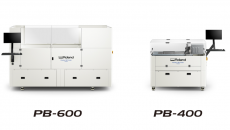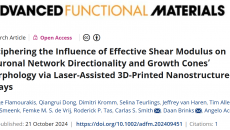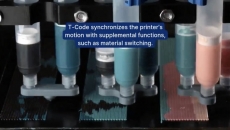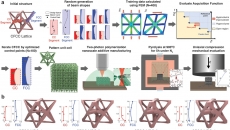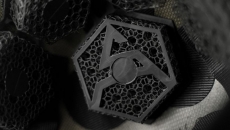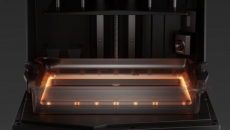[據(jù)3Ders網(wǎng)站2015年1月3日?qǐng)?bào)道]隨著目前打印的塑料電子器件性能被認(rèn)為是接近于40年前的水平,,這種進(jìn)步仍在以指數(shù)級(jí)增長(zhǎng),,尤其是在高質(zhì)量和低成本制造方法領(lǐng)域,。

QQ截圖20150106090505.png (307.19 KB, 下載次數(shù): 290)
下載附件
2015-1-6 09:05 上傳
簡(jiǎn)單地說(shuō),制造塑料的成本要低于硅(主要是因?yàn)楣韫に囆枰婵蘸透邷丨h(huán)境),,塑料電路的制造僅僅涉及利用低成本液體進(jìn)行簡(jiǎn)單噴墨打印和加工,。

QQ截圖20150106090549.png (638.68 KB, 下載次數(shù): 295)
下載附件
2015-1-6 09:05 上傳
考慮到這些情況,問(wèn)題就演變成了3D打印的進(jìn)步如何不僅可以進(jìn)一步壓縮成本,,制造更強(qiáng)大的設(shè)備,,而且是什么時(shí)候?最大的障礙是如何將當(dāng)今集成電路的微米級(jí)功能進(jìn)行復(fù)制,。 最近,,IBM位于瑞士蘇黎世的研究實(shí)驗(yàn)室通過(guò)重置原子力顯微鏡開發(fā)出一種設(shè)備,能夠利用有機(jī)材料創(chuàng)建納米級(jí)分辨率的3D模型,。此種材料的其他用途是作為創(chuàng)建電路的掩膜,。

QQ截圖20150106090700.png (166.87 KB, 下載次數(shù): 292)
下載附件
2015-1-6 09:06 上傳
為創(chuàng)建這種設(shè)備,該團(tuán)隊(duì)在一個(gè)AFM探針尖端增加了一個(gè)加熱器,,利用它對(duì)有機(jī)分子玻璃或聚鄰笨聚合物(PPA)薄膜材料進(jìn)行解吸,。當(dāng)加熱時(shí),這兩種材料蒸發(fā),,無(wú)殘留,。當(dāng)在更復(fù)雜模式下工作時(shí),這種材料可作為采用立體光刻制造方法生產(chǎn)電路的掩膜,。用于創(chuàng)建電子器件額外必要的材料通過(guò)掩膜上的圖案應(yīng)用到電路板上,。
由于開發(fā)出這一制造工藝,IBM已將該設(shè)備授權(quán)給SwissLitho AG公司,。該公司是一家剛成立的公司,,正在對(duì)此項(xiàng)工藝進(jìn)行改進(jìn)。這家公司名為NanoFrazor的設(shè)備已能夠超越用在半導(dǎo)體制造工藝中傳統(tǒng)的電子束光刻設(shè)備,。與硅制造設(shè)備相比,,該設(shè)備價(jià)值50萬(wàn)美元。SwissLitho AG公司對(duì)設(shè)備進(jìn)行改進(jìn)涉及更快地創(chuàng)建出能夠制造出更多種類材料模型的模式,。
如果Bryzek的理論是正確的,那么距離能夠?yàn)榭纱┐麟娮赢a(chǎn)品和其他小型連接設(shè)備便宜地制造塑料電路板不遠(yuǎn)了,。如果打印的塑料電子器件真正做到給人眼前一亮的感覺,,那么由于僅需更小作坊、企業(yè),甚至更大公司只要有設(shè)備能夠真正3D打印自己的電路板,,它很可能消除大型半導(dǎo)體公司,。隨著增材制造工藝成本的不斷下降,未來(lái)這種方法不會(huì)太遙遠(yuǎn),。
(工業(yè)和信息化部電子科學(xué)技術(shù)情報(bào)研究所 宋文文)
原文如下:
Recent developments in 3D printed plastic electronics showing promise
Jan 3, 2015 | By Simon
http://www.3ders.org/articles/20 ... howing-promise.html
With today's printed plastic electronics performing nearly just as well as what was considered state-of-the-art forty years ago, it comes with little surprise that advancements are still growing at an exponential level... particularly in higher quality and lower cost fabrication methods.
Simply put, plastic costs less to build than silicon (primarily due to the omission of vacuums and high temperature needs of silicon), and the fabrication of plastic circuit boards involve little more than simple inkjetting and processing with low-cost liquids.
With these facts in mind, the conversation then turns into how advancements in 3D printing can not only drive the costs further down and create even more powerful device, but also, when? The largest hurdle has primarily been in duplicating the micron-level features seen in today's integrated circuits.
More recently, an IBM Research lab in Zurich, Switzerland developed a device by reconfiguring an atomic force microscope so that it was capable of creating 3D patterns with a nanometer-scale resolution in organic material. Among other uses for the material is as a mask for creating circuits.
To create their device, the team added a heater on the tip of an AFM probe and used it to desorb material from a thin film of organic molecular glass or polyphthalamide polymer (PPA). When heated, both materials evaporate and thus, leave no residue behind. When done in more complex patterns, the material can serve as a mask for producing circuits with stereolithography fabrication methods. The additional necessary materials for creating the electronics are then applied to the board via the pattern on the mask.
Since developing this fabrication method, IBM has licensed the device to SwissLitho AG, a startup that is developing several enhancements for the technology. Their version of the device, the NanoFrazor, has been able to outperform conventional electron-beam lithography equipment used in the semiconductor manufacturing process and costs just $500,000 compared to up to $30 million for silicon manufacturing equipment. The enhancements that SwissLatho AG are currently working on involve faster speeds for creating the patterns and models that are able to make patterns out of a wider variety of materials.
"Plastic circuits could end up having perhaps 1/1,000th the cost-per-area of the equivalent silicon device," said Dr. Janusz Bryzek, founder of the Trillion Sensor movement.
If Bryzek's theory is correct, then the potential for being able to cheaply fabricate plastic boards for wearable electronics and other small connected devices isn't too far off of the horizon. If the printed plastic electronics truly do make an impact, it will likely eliminate large semiconductor companies due to smaller workshops, firms and even larger companies being able to literally 3D print their own circuit boards...so long as they have the equipment. As the cost of additive manufacturing methods continue to go down, that future might not be too far off.
|

